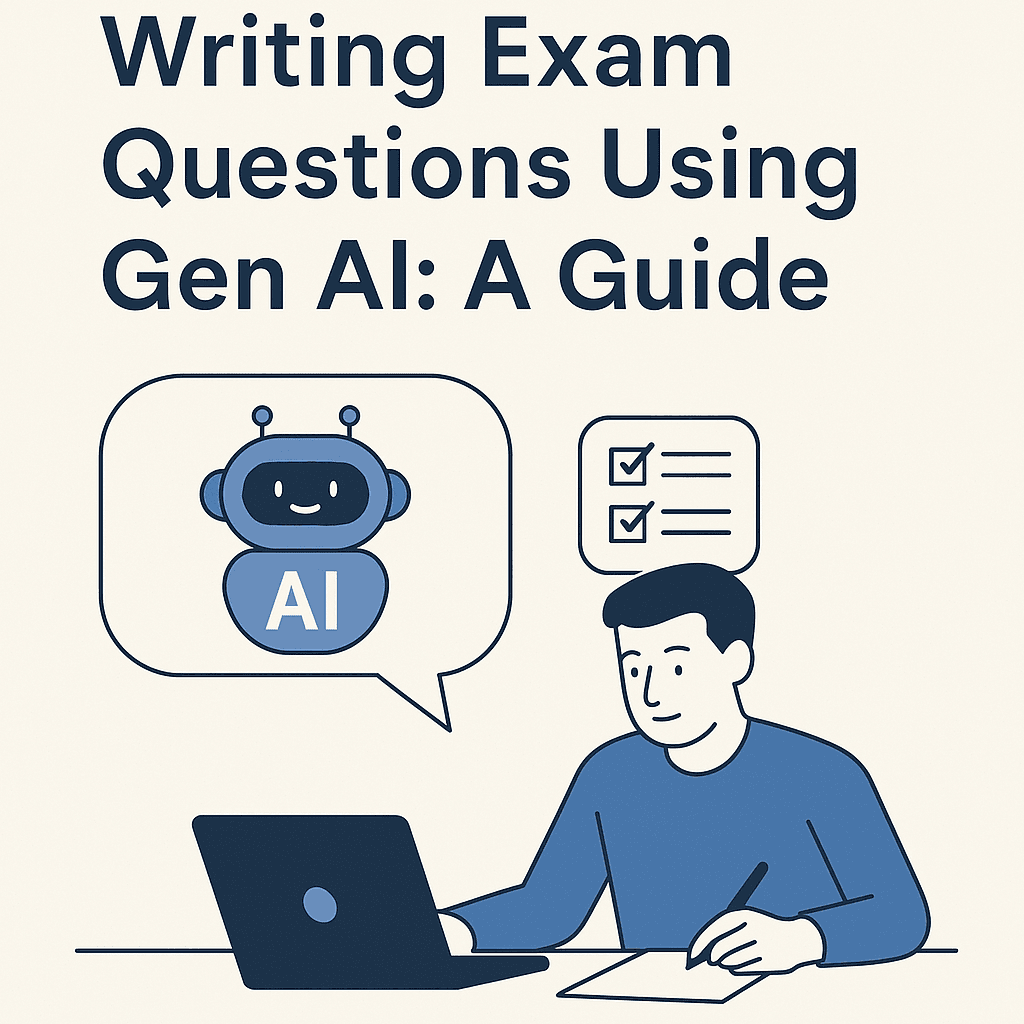
Writing exam questions using Gen AI is rapidly becoming a transformative practice in modern education. With generative AI tools like ChatGPT, Gemini, and Claude gaining traction, educators now have access to fast, reliable support for designing varied, standards-aligned, and differentiated exam questions for all learning levels.
Assessment design is a core component of teaching. However, it can be time-consuming and challenging—especially when trying to create fresh questions across Bloom’s Taxonomy or align them with specific curriculum outcomes. This is where writing exam questions using Gen AI can provide immense value.
What Is Generative AI?
Generative AI refers to artificial intelligence models that can produce original content—text, images, and more based on patterns learned from massive datasets. In education, this includes creating learning materials, solving complex queries, and most importantly, generating assessment content tailored to different objectives.
ChatGPT, for instance, can be prompted to produce multiple-choice questions (MCQs), short-answer prompts, case studies, and higher-order thinking questions, all within seconds.
The Influence of Case Studies on Public Policy Development
Why Writing Exam Questions Using Gen AI Is a Game Changer
Educators often struggle with:
- Creating enough variety in test formats
- Designing questions that align with learning outcomes
- Ensuring cognitive diversity across assessments
- Differentiating questions for mixed-ability groups
Writing exam questions using Gen AI offers a powerful solution by reducing the workload while maintaining academic rigour and creativity. With the right prompts, educators can generate high-quality questions and modify them to suit different learning contexts.
Practical Examples of Gen AI in Exam Question Creation
1. Multiple Choice Questions (MCQs)
Prompt:
"Create five multiple-choice questions on the topic of renewable energy for Year 9 students. Each question should have four options and one correct answer."
Output (example):
Q1: What is the main source of solar energy?
A) Wind
B) Fossil fuels
C) The Sun
D) Nuclear energy
This is ideal for quick knowledge checks and automated testing systems.
2. Bloom’s Taxonomy-Aligned Questions
Prompt:
"Generate one question for each Bloom’s level on the topic of cell biology for GCSE students."
Output:
- Remembering: What is the function of the mitochondria?
- Understanding: Explain how the cell membrane controls what enters and leaves the cell.
- Applying: Use your knowledge of osmosis to predict what will happen to a cell placed in salt water.
- Analysing: Compare and contrast plant and animal cells.
- Evaluating: Assess the importance of the nucleus in cellular function.
- Creating: Design an experiment to observe cell division.
This approach ensures well-rounded assessment that targets multiple levels of cognitive demand.
3. Case-Based or Scenario Questions
Prompt:
"Create a scenario-based question for a business studies exam where students must apply knowledge of marketing strategies."
Output:
“You are the marketing manager of a new sportswear brand entering a saturated market. Describe three marketing strategies you would use to gain customer attention and justify your choices.”
This question assesses application, evaluation, and reasoning—all critical in modern exams.
Best Practices for Writing Exam Questions Using Gen AI
To maximise the benefits of writing exam questions using Gen AI, follow these best practices:
- Use Specific Prompts: Provide clear subject, level, format, and objective instructions.
- Review and Refine: Always review AI-generated content to ensure accuracy and alignment with your context.
- Localise Content: Tailor questions to reflect local curriculum, cultural references, or institutional standards.
- Use for Drafting, Not Replacing: Treat AI as your co-creator. Human expertise is still essential for nuance, fairness, and question calibration.
- Save and Reuse Prompts: Build a prompt library that can be reused across subjects and year levels.
Tools That Support AI Question Generation
- ChatGPT (OpenAI) – Flexible, freeform tool for generating various question types.
- QuestionWell – AI tool focused specifically on creating quizzes and exportable assessments.
- MagicSchool AI – A teacher-focused platform for generating aligned questions, rubrics, and learning materials.
- Test Generator AI – Create summative-style exams with instant export to Word or PDF.
Ethical Considerations
When writing exam questions using Gen AI, educators must:
- Avoid overreliance on AI-generated content
- Verify academic accuracy and subject specificity
- Ensure accessibility and fairness
- Avoid biased or culturally insensitive content
- Maintain data privacy when using institutional platforms
Final Thoughts
Writing exam questions using Gen AI is a time-saving and creative way to enrich the assessment process. It empowers educators to focus more on pedagogy and student engagement while reducing repetitive workload. With proper oversight and thoughtful application, generative AI is not just a tool—it’s a partner in advancing modern assessment design.
Visit The Case HQ for 95+ courses
Read More:
Case Studies in Education: A Comprehensive Overview
The Emergence of Case Studies in Behavioral Sciences
Influencing Change: Case Studies in Nonprofit Organizations
Case Studies: Paving the Way for Inclusive Education
Unveiling the Power of Case Studies in Renewable Energy
Case Studies in Sports: A Game-Changing Approach
Innovative Practices: How Case Studies Influence Product Design
Case Studies in Economics: A Closer Look
Utilizing Case Studies for Effective Disaster Management
AI-Powered Learning: Enhancing Student Engagement and Outcomes
Ethical Considerations of AI in Education: Balancing Innovation and Privacy
Leveraging AI for Student Success: Tools and Techniques
https://thecasehq.com/powerful-guide-to-writing-exam-questions-using-gen-ai-effectively/?fsp_sid=1018
Comments
Post a Comment